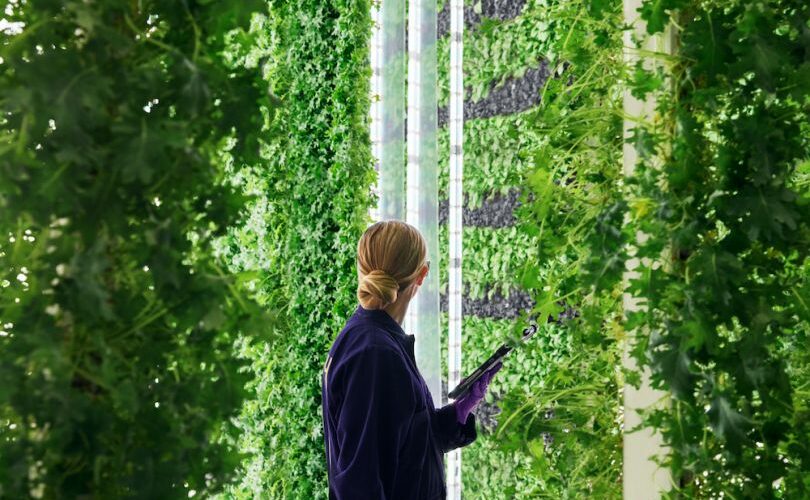
AI and robot-run farms are transforming agriculture. Source: Plenty
AI and robot-run farms are transforming agriculture
- Ag-tech startup Plenty’s vertical farm produces 400 times more food per acre than a flat farm.
- With employed robots and AI, Plenty can be grown year-round while using 95% less water and 99% less land.
One of the oldest and most fundamental professions in the world is agriculture and farming and looking back, humanity has come a long way over the millennia in how we farm and grow crops with the evolution of various technologies. Over time, as the world population continues to grow and land becomes more scarce, people have realized the need to get creative and become more efficient in farming.
This also means using less land to produce more crops and increasing the productivity and yield of those farmed acres. Worldwide, agriculture is a US$5 trillion industry, and now the industry is turning to artificial intelligence (AI) and robotic technologies to help yield healthier crops, control pests, monitor soil and growing conditions, organize data for farmers, help with the workload, and improve a wide range of agriculture-related tasks in the entire food supply chain.
In fact, we have reached a stage where robots and AI are starting to contribute more, at a faster clip to the agricultural landscape than anyone saw coming. More recently, promising vertical farming startups like Plenty AI have become known for pushing the boundaries of farming towards the sky, literally and figuratively.
Plenty AI
As its name suggests, San Francisco-based ag-tech startup Plenty AI’s vertical farm produces 400 times more food per acre than a flat farm. The beauty of vertical farms is that they can be placed anywhere indoors, making them crucial in a time where farmable land is on the decline.
What makes Plenty different is that its products can be grown year-round by employing robots and AI that continually make adjustments to improve the growth quality of the goods – all while using 95% less water and 99% less land.
“Imagine a 1,500-acre farm. Now, imagine that fitting inside your favorite grocery store, growing up to 350x more. That’s efficient,” Plenty wrote on its website. Co-founder Nate Storey, in an interview with Forbes, said, “The reality is, there are five places in the world where you can grow fresh fruits and vegetables really economically, and all of that land is used up at this point. Vertical farming exists because we want to grow the world’s capacity for fresh fruits and vegetables, and we know it’s necessary.”
On its website, Plenty’s farms look like rows of plants situated next to each other, growing vertically and hanging from the ceiling. There are robots to move them around and the company makes use of AI to manage water, temperature, and light. LED lights mimic as the sun is situated above as the plants’ environment is continually optimized to make sure they have the best crops possible.
Additionally, the reasons why indoor vertical farming is superior are varied: according to the company’s website the technology “frees agriculture from the constraints of weather, seasons, time, distance, pests, natural disasters, and climate” and produces GMO-free plants at scale with ”extraordinary flavor.”
Plenty’s AI facilities manage all the variables of water, temperature, and light, and continually learns and optimizes how to grow bigger, faster, better crops. On top of all that, the water used is all recycled and the evaporated water in the air is captured for reuse. The flagship farm in San Francisco is using 100% renewable energy, says Plenty.
In supply chain terms, the perk of vertical farming is that the fruits and vegetables aren’t grown thousands of miles away or more from a city; instead, at a warehouse nearby. This eliminates transport miles, a move useful for reducing millions of tons of yearly CO2 emissions and prices for consumers. Given how imported fruits and vegetables are usually more costly, vertical farms could solve this problem.
“Supply-chain breakdowns resulting from Covid-19 and natural disruptions like this year’s California wildfires demonstrate the need for a predictable and durable supply of products can only come from vertical farming,” Storey said, adding that the future will be quite remarkable and that the size of the global fresh fruit and vegetable industry will be multiples of what it is today.
Plenty intends to branch out (no pun intended) to opening vertical farms across the country and beyond. The startup has already received US$400 million in investment capital from SoftBank, former Google chairman Eric Schmidt, and Amazon’s Jeff Bezos. It’s also struck a deal with Albertsons stores in California to supply 430 stores with fresh produce.
READ MORE
- Global concerns rise over alleged cyber hacking activities linked to China
- China’s new tech policies challenge Intel and AMD in a shifting landscape
- Saudi Arabia could become the largest player in the AI industry
- How vulnerable are we to cyber threats in the digital age? Here’s what IBM found
- Wise: Revolutionizing travel and finance in Malaysia
